Uncategorized
American synagogues are closing at a record rate. This retired judge is rescuing their stained glass windows.
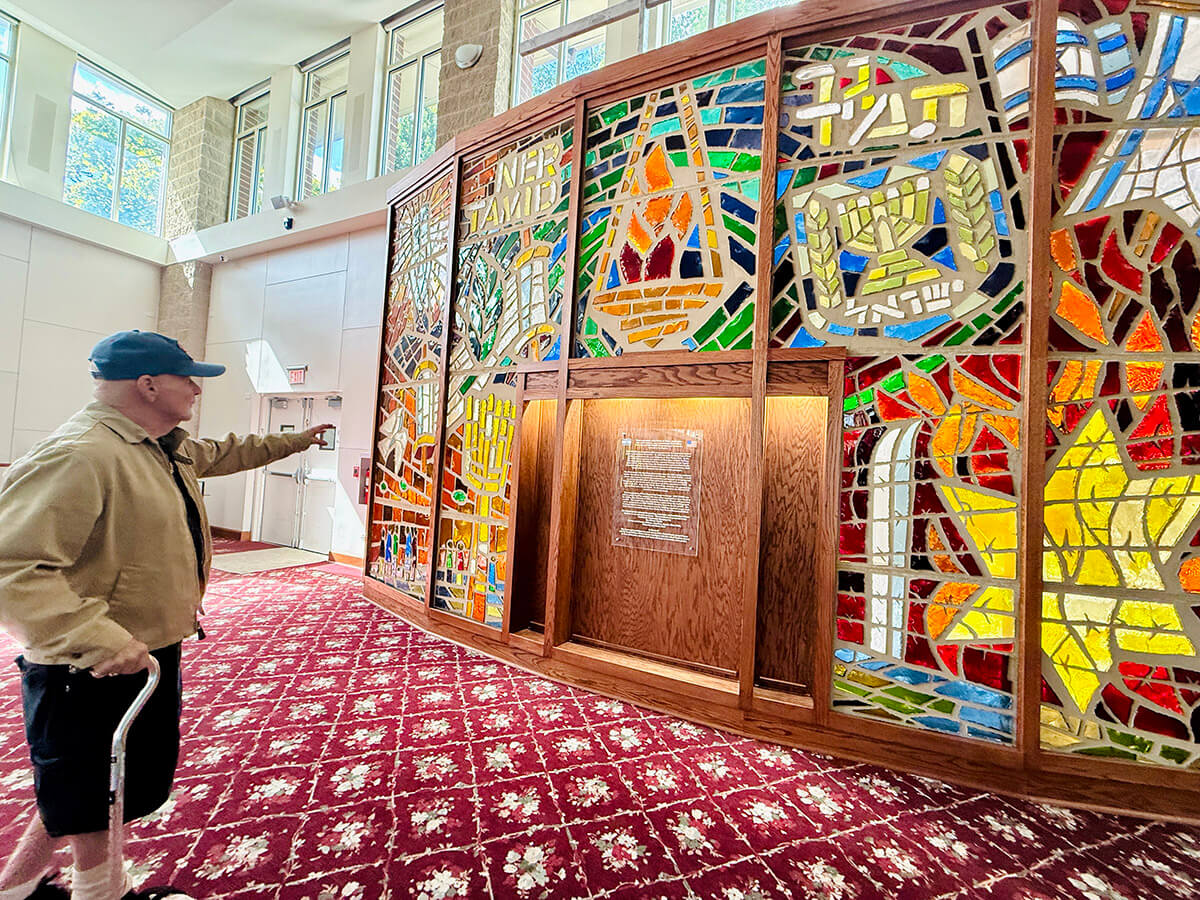
CHICAGO — Jerry Orbach moves through the sanctuary of Northbrook Community Synagogue with the practiced eye of a man who’s spent years rescuing pieces of a fading world. The suburban Chicago congregation glows with stained glass saved from shuttered synagogues, their colors reframed along these walls. What began as one man’s mission has turned the space into a living museum — a collage of light and loss.
A large gold Star of David hangs from a chain around Orbach’s neck, catching the light from the windows he’s saved from seven shuls. At 79, the retired judge has made a second career of rescuing what others have left behind: stained glass from synagogues that have closed, merged, or fallen into disrepair.
He isn’t just saving glass; he’s salvaging light — the one thing that never stops traveling.
Each panel is marked by a small plaque: the name of the congregation, the town it once illuminated, the year it died. When the sun hits them just right, color ripples across the walls like ghosts, a chorus of light still singing long after the voices are gone. “A continuation instead of a destruction,” he says, as if arguing a case.
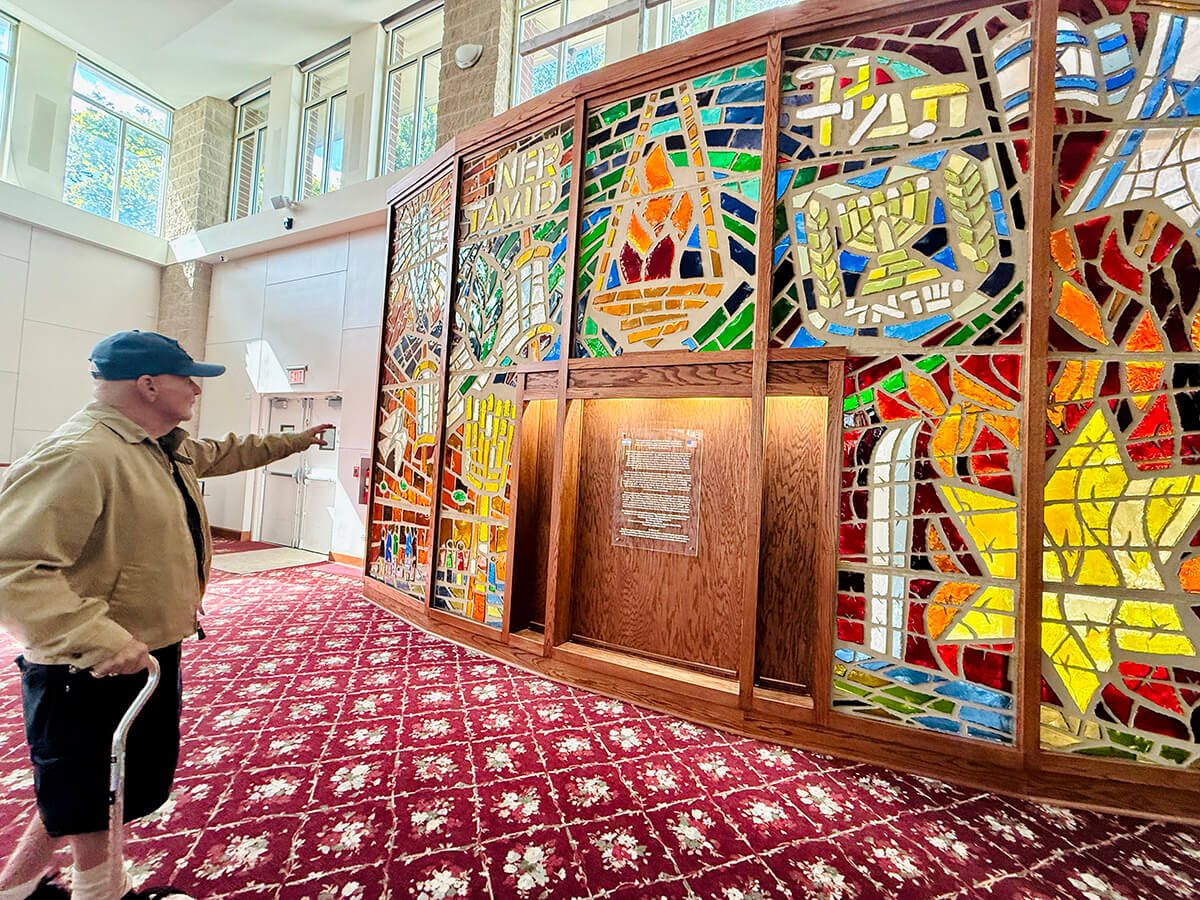
For more than a century, the number of synagogues in America steadily climbed, a reflection of immigration, assimilation, and Jewish ambition. But by the 1990s, that momentum stalled. In the decades that followed, it reversed. There are roughly 20% fewer synagogues today than there were in 1990, according to data gathered by Alanna E. Cooper, a Jewish Studies professor at Case Western Reserve University. For the first time in American history, more synagogues are closing each year than opening.
The walls of Northbrook Community Synagogue now hold what those closures leave behind: fragments of glass salvaged from sanctuaries across the post-industrial Midwest, where factories shuttered and congregations dwindled. Orbach has become a one-man preservation society.
A history in glass
Stained glass has long been a marker of Jewish arrival in America. When immigrant congregations began erecting monumental synagogues in the early 1900s, they built them with arches, domes, and large window apertures. Glass became the medium of belonging.
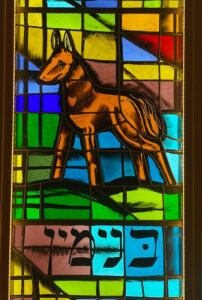
In cathedrals, stained glass told the stories of saints. In synagogues, it told the story of survival. Early designs depicted the 12 tribes, the days of creation, the Exodus from Egypt. Later came darker panels, fractured blues and reds evoking the Holocaust, followed by bursts of gold and white celebrating the creation of the State of Israel. Across a century of Jewish life, the art evolved into a visual Torah of endurance.
The factories closed. The congregations scattered. But the windows remain: fragile, luminous, still looking for a home.
Orbach leads me into a small elevator, one hand steadying his cane as the doors close. “You’re gonna like this,” he says, as the bell dings and the elevator jolts to a stop.
The basement sprawls beneath the entire building, a hidden warren of storage rooms and concrete corridors. One room is a large gym. Another section is soon to become indoor pickleball courts. But in a far corner, the scene could be straight out of an Indiana Jones movie. This is where Orbach has built something else: a warehouse of memory.
Wooden crates line the walls, some open, others nailed shut. Inside are stained-glass windows that have yet to find a new home — towering panels from Beth Achim synagogue in Southfield, Michigan, each thirteen feet tall and three feet wide. For now, they rest here, waiting for wherever their journey next takes them, like the vessels of a traveling tabernacle.
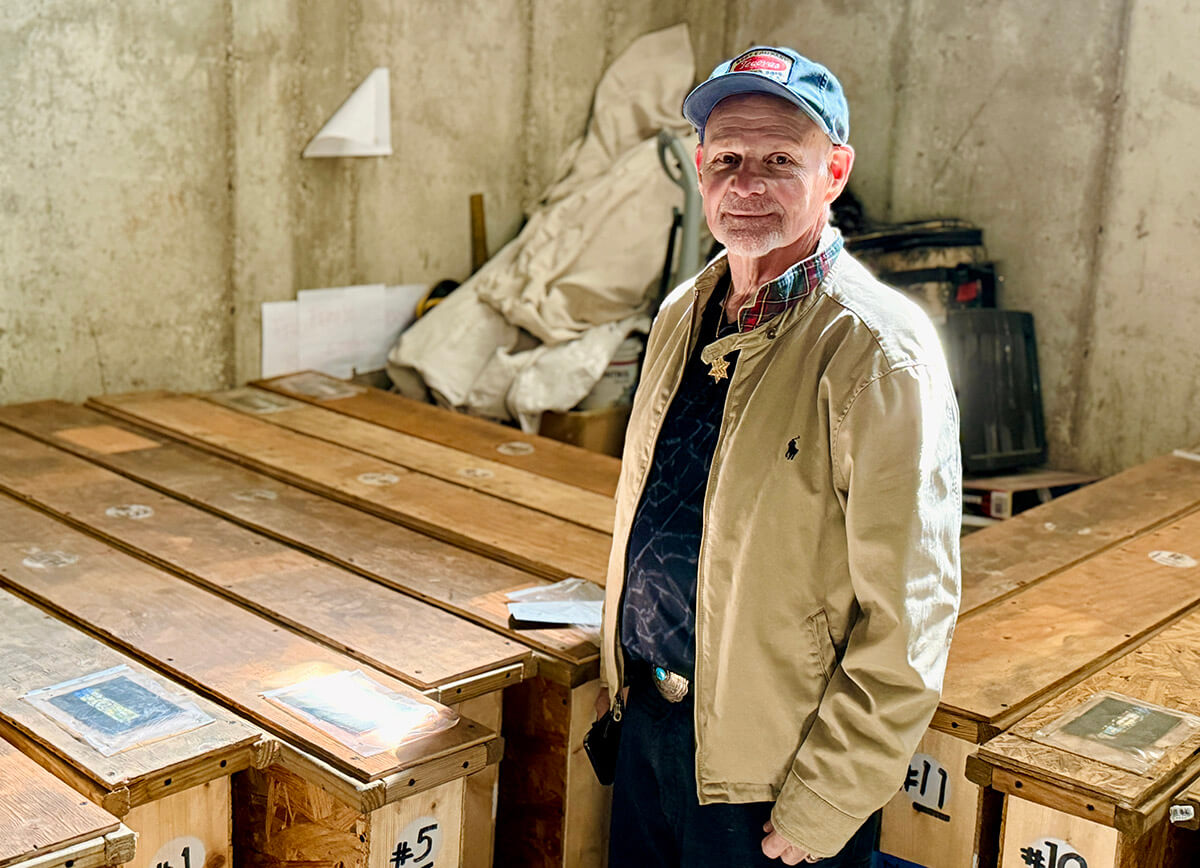
Orbach lifts his phone, flicking on the flashlight. Dust drifts through the beam. The air smells faintly metallic, like old pews and time. He runs the light along the edge of a crate, tracing the outline of a hidden window.
“I just got these in two weeks ago,” he says, like a shopkeeper showing off new stock. “Seven for the holidays, seven for the days of creation. They’re gorgeous.”
He steps closer to a crate, resting his hand on the wood as if on a headstone. This, he said, is how memory becomes a kind of faith.
The case for light
A son of Chicago, Orbach was born in Humboldt Park to parents who fled pogroms in Eastern Europe — his mother from Ukraine, his father from Poland. When he was eight, the family moved north to Albany Park, then a humming center of Jewish life. He’s stayed close to the city ever since: studying law at Loyola, serving as a prosecutor and alderman, and later, in 1988, taking the bench in Cook County. In time he rose to head the court’s law division in District Two, a job that taught him to listen before ruling. He retired two decades ago, though he now mediates and arbitrates cases — a judge, it seems, never entirely off duty.
A few of Orbach’s earliest rescues were the panels from his childhood synagogue in Albany Park. They once illuminated the sanctuary where he became bar mitzvah, where he was married, where his parents once prayed. Reinstalled now in Northbrook, they’ve since framed his grandchildren’s baby namings. “They sold the building to a church,” he said. “I couldn’t stand the idea of those windows ending up in a dumpster.”
Something shifted. He started calling contractors, preservationists — anyone with a ladder and a conscience. Soon he was showing up at demolition sites, paying crews out of pocket to let him climb the scaffolding and pry the glass from the walls. Once, at Mikro Kadosh Anshei Ticktin, an old Chicago congregation, he and his crew worked through the night, prying the stained glass from the front while a bulldozer tore into the back of the building. “By the end, there was one wall left,” he said. “It was shaking while we got the last window out.”
He talks about the windows the way some people talk about those who once prayed beneath them, as if they still have a pulse. “If you keep the memory of the shuls alive,” he said, “the people in them are alive too.”
From ruin to renewal
Among Orbach’s most prized rescues are a set of stained-glass windows from Saginaw, Michigan — luminous panels manufactured in France and salvaged just before their synagogue was torn down. He brought them to Northbrook several years ago, giving their light a second life.
A few months after Orbach installed the Saginaw windows, Cooper — the scholar who tracks synagogue closures and the fate of their sacred objects — flew in from Cleveland to see them. She’d been studying what happens to the sacred items left behind when synagogues close: Torah scrolls, yahrzeit plaques, arks, pews, memorial lights. But the stained glass, she said, posed the hardest questions.
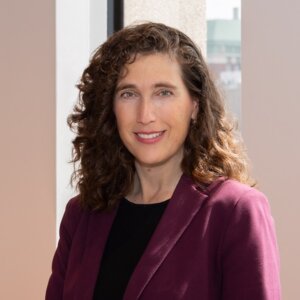
Stained-glass windows don’t have a sacred status like a Torah scroll or even the building itself. They carry a different kind of holiness. “I’ve heard many congregations describe their windows as the soul of their congregation,” Cooper said.
She found in Orbach what her fieldwork had only theorized. “He’s creating an afterlife for these windows,” she said at a dedication ceremony at Northbrook, where they both spoke.
Standing before the crowd that day, Cooper described the scene she’d witnessed when windows were removed from Ahavath Israel in Kingston, New York, which Orbach also rescued and relocated to Northbrook. Cooper recalled workmen carrying the panels to their crates as the last members of the congregation looked on. “As they lowered the windows into the boxes,” she said, “it felt like a burial.”
Now she gestured toward the sanctuary, the glass alive with color once more. “And this,” she said, “is the afterlife.”
In his own sanctuary
Orbach has one more thing to show me, in his two-story home on a quiet suburban street. Rusty, his six-year-old rescue mutt, bounds to the door. His wife, Noreen, waves from the hallway.
The foyer is lined with photos of his two daughters and their families. Hanging above the entryway are two stained-glass windows he salvaged years ago from a shuttered synagogue in Lakeview, Illinois, where he used to go for minyan. The site is now condos.
“In my own way, this is how I keep those shuls alive,” he says, glancing up at the glass.
The post American synagogues are closing at a record rate. This retired judge is rescuing their stained glass windows. appeared first on The Forward.
Uncategorized
A Saturday night in Portland, very close to the ICE building
ס׳איז געווען אַ שטילע נאַכט אין פּאָרטלאַנד, אָרעגאָן. מײַן חבֿר ברונאָ, אַ משפּחה־דאָקטער װאָס אַרבעט אויפֿן געביט פֿון עפֿנטלעכן געזונט פֿאַר דער שטאָט, האָט פּאַרקירט זײַן אױטאָ אין אַ טונקעלער גאַס אַ פּאָר בלאָקן פֿונעם „אײַס“־קאָמפּלעקס.
„אײַס“ זענען די ראשי־תּיבֿות פֿון דער אַמעריקאַנער אימיגראַציע־אַגענטור, וואָס האָט זינט אָקטאָבער 2024 אַרעסטירט מער ווי 185,000 אומדאָקומענטירטע אימיגראַנטן.
„װילסט טראָגן דעם האָן־קאָסטיום?“ האָט ער מיך געפֿרעגט. דאָס ערשטע מאָל אין מײַן לעבן הער איך אַזאַ פֿראַגע. איך זאָג זיך אָפּ, און ער קװעטשט זיך אַרײַן אין דעם אייגנאַרטיקן פֿאַרשטעלעכץ.
אין פּאָרטלאַנד בין איך געפֿאָרן צוליב אַ קאָנפֿערענץ. נישט געקוקט אױף די בויך־סבֿרות פֿון דאָנאַלד טראָמפּ, איז דאָס אַ שײנע שטאָט, פֿול מיט אײגנאַרטיקע װעגעטאַרישע רעסטאָראַנען, מאָדישע שענקען און אַ סך בריקן אַרום אַ בילד־שײנעם טײַך. מע האָט אויך געזען הײמלאָזע אױף די גאַסן אָבער דאָס איז שוין אַ טײל פֿון דער לאַנדשאַפֿט אין כּמעט יעדער גרויסער אַמעריקאַנער שטאָט, אַ סימן פֿון אונדזערע אומגלײַכקײטן.
נאָר צופֿעליק כאַפּט מען זיך אַז נישט אַלץ איז פֿױגלדיק. אָפּשטאַטנדיק אַ װיזיט אין אַ היגער קליניק, האָב איך באַמערקט די באַװוּסטע שילדן, װאָס װאָרנט „אײַס“ נישט אַרײַנצוטרעטן אָן אַ יורידישן באַפֿעל. פֿאַרבײַגײענדיק אױף דער גאַס, הער איך אונטער װי עס רעדט אַ פּאָרל. זי: „איך באָד זיך אין חובֿות. אַפֿשר זאָל איך זיך פֿאַרשרײַבן פֿאַר אַן אײַס־אַגענט, מע זאָל מיר פֿאַרגעבן די חובֿות.“ ענטפֿערט ער אַ שאָקירטער: „רעד נישט אַזעלכע רײד אין דער עפֿנטלעכקײט!“
װי באַװוּסט װערט פּאָרטלאַנד די טעג אָפֿט מאָל דערמאָנט אין די נײַעס, װײַל טראָמפּס אױפֿמערק האָט זיך פֿיקסירט אױף איר, װוּ עס בושעװעט כּלומרשט אַ מלחמה. כאָטש די אײנציקע קריג װאָס איך האָב דאָרט געזען איז געװען דאָס שטופּעניש אין מײַן האָטעלס לאָבי־באַר, האָב איך באַשלאָסן זיך אַריבערצוכאַפּן אין די בלאָקן לעבן „אײַס“־בנין. און דערפֿאַר האָט מײַן חבֿר זיך אָנגעטאָן דעם הון־קאָסטום.
צוליב דעם וואָס איך בין אָנגעקומען אין פּאָרטלאַנד נאָך שבת האָב איך פֿאַרפֿעלט די דעמאָנסטראַציע מיט אַ 100 מענטשן װאָס איז פֿריִער פֿאָרגעקומען, נאָר איך האָב יאָ געזען דעם עולם װאָס זאַמלט זיך דאָרט חדשים לאַנג, און װאָס טראָמפּ װיל באַקעמפֿן מיט דער נאַציאָנאַלער גװאַרדיע.
אַלץ איז געװען גאַנץ פֿרידלעך, כאָטש אַקטיװ. מ׳איז געשטאַנען אין קרײַזלעך, רעדנדיק, אַ מאָל גאַנץ הױך. עטלעכע „יוטובער“ טיפּן האָבן פֿילמירט.
ניק שירלי, אַ 22-יאָריקער װידעאָ־בלאָגער און „קאָנטענט־שאַפֿער“, האָט מיר געזאָגט, „איך בין דאָ צו רעדן מיט מענטשן [אױפֿן אינטערנעט] צו זאָגן זײ װאָס דאָ קומט פֿאָר. אַנטי־פֿאַ און פּראָטעסטירער פֿאַרנעמען די געגנט צו פּראָטעסטירן ׳אײַס׳.“ אַזעלכע פֿילמירערס, אַרומשפּאַנענדיק מיט אַפּאַראַטן אין דער האַנט און מאָבילקעס אױף סעלפֿי־שטעקנס, האָבן געשאַפֿן גיכער אַ מין צירק־געפֿיל, איידער אַן אײַנדרוק פֿון אַ קאָכעדיקן פּראָטעסט.
אַפֿשר אַ פֿופֿציק מענטשן זײַנען געשטאַנען אױף דער גאַס לעבן דעם „אײַס“־בנין יענעם שבת־צו־נאַכט, שרײַענדיק אױף די אַגענטן װאָס האָבן זיך אַװעקגעשטעלט אױפֿן דאַך. טעראָן, אַ 19-יאָריקער, האָט געזאָגט אַז ער איז געקומען כּדי זיך אַקעגנצושטעלן קעגן „אײַס.“ ניקאָל, 22 יאָר, האָט געזאָגט, „מע נעמט אַװעק אונדזערע קאָנסטיטוציאָנעלע רעכט. דערפֿאַר זײַנען מיר דאָ.“
ברי, אַ יונגע, נידעריקע פֿרױ איז געשטאַנען אין מיטן אַ קרײַזל מענטשן, האַלטנדיק פֿעסט אין דער הײך אַ מעקסיקאַנער פֿאָן. „װאָס טוסטו דאָ?“ האָב איך זי אַ פֿרעג געטאָן. „מיר פּראָטעסטירן קעגן דעם ׳אײַס׳־בנין און לאָזן פֿלאַטערן די פֿאָן כּדי אַרױסצוּװײַזן סאָלידאַריטעט מיט אונדזערע מעקסיקאַנער ברידער און שװעסטער, װאָס װערן עטניש גערײניקט.“
אַז אַ פֿרױ, װאָס האָט נישט געװאָלט געבן איר נאָמען, האָט געהערט אַז איך שרײַב פֿאַר אַ ייִדישער צײַטונג, האָט זי האַסטיק אַ פֿרעג געטאָן, „װאָס מײנסטו װעגן עזה? האַלטסטו דאָס פֿאַר אַ גענאָציד?“
אױפֿן װעג צום עולם טראָפּמיסטן (אַ היפּשע צאָל, כאָטש אַ קלענערער װי די לינקע – מיט טראָמפּ־ און אַמעריקאַנער פֿאָנען), האָב איך געטראָפֿן אַ יאַט אָנגעטאָן אין שװאַרץ. „איך װיל גאָר נישט זאָגן, נאָר ס׳איז אַ מזל אַז קײנער איז דאָ נאָך נישט דערהרגעט געװאָרן.“
אַ פּאָליצײ־אױטאָ איז אַדורכגעפֿאָרן. „בלאָקיר נישט די גאַס! זײַט אײדל אײנער צום צװײטן!“ האָט מען געפֿאָלגט. מײַן חבֿר מיטן הון־קאָסטיום האָט געטאַנצט צו דער מוזיק װאָס עמעצער האָט געשפּילט.
אַ פֿאָן־טרעגער צווישן די טראָמפּיסטן האָט מיר באַשריבן זײַנע צילן. „איך בין דאָ צו פֿאַרברענגען, אָנצוקוקן דעם עולם און פֿאַרטײדיקן די פּאַטריאָטן.“
אַ פֿרױ און אַ בחור זענען געשטאַנען אױפֿן ראַנד טראַטואַר. „פֿאַר װאָס זײַט איר דאָ?“ האָב איך אַ פֿרעג געטאָן.
„איך בין אַ שטיצער פֿון די פּאַטריאָטן,“ האָט זי זיך אָפּגערופֿן. „אָנגעקומען בין איך אין פּאָרטלאַנד צו 18 יאָר װי אַ נישט־חתונה־געהאַטע מאַמע. איך האָב געדאַרפֿט שפּעטער פֿאַרלאָזן די שטאָט װײַל איך האָב מער נישט געקענט פֿאָרן מיט דער צופֿאָר־באַן. דראָג־אַדיקטן. ווילדע אומרוען. מע באַגנבֿעט אײנער דעם צװײטן. איך הייס בעט. אָט איז מײַן זון לאָראַן.“
„מעג איך אַראָפּנעמען אײַער בילד?“
„װאָסער צײַטונג, װידער?“
„אַ ייִדישע.“
„אין דעם פֿאַל, דאַרף איך ענדיקן מיט דעם: יעזוס איז דער מלך.“
איך האָב אַ קוק געגעבן אױפֿן האַנטזײגער און זיך געכאַפּט אַז ס׳װערט שפּעטלעך. איבערגעכאַפּט אַן אינדיש־װעגעטאַרישע װעטשערע, זײַנען מיר צוגעפֿאָרן צום פֿליפֿעלד. מײַן חבֿר איז שױן געװאָרן אױס האָן.
כ׳בין אַהײמגעפֿאָרן מיט פּאָרטלאַנדער זכרונות פֿון פֿאָנען און פֿאָטאָגראַפֿן.
The post A Saturday night in Portland, very close to the ICE building appeared first on The Forward.
Uncategorized
Michigan Lt. Gov. Garlin Gilchrist Attacks Israel During Democratic Primary Campaign for Governor

Michigan Lt. Gov. Garlin Gilchrist speaks at a “Hands Off” protest at the Michigan Capitol in Lansing, Michigan, on April 5, 2025. Photo: Andrew Roth/Sipa USA via Reuters Connect
Michigan Lt. Gov. Garlin Gilchrist has sparked backlash among the state’s Jewish community in recent weeks over his fierce condemnations of Israel while running in the Democratic primary to be Michigan’s next governor.
Gilchrist has sharpened his rhetoric against Israel, falsely accusing the Jewish state of both committing a “genocide” against the Palestinian people and purposefully inflicting famine across Gaza.
Since entering the race, Gilchrist has embarked on a full-court press to galvanize Michigan’s Arab community behind his campaign. Gilchrist recently spoke at events held by the American-Arab Anti-Discrimination Committee and ArabCon, in which he condemned Israel for supposedly committing a “genocide” in Gaza. He has also vowed not to accept money from organizations that support Israel’s war against Hamas, including the American Israel Public Affairs Committee (AIPAC), a lobbying group that seeks to foster bipartisan support for the US-Israel alliance.
“This is not a matter of opinion; it is a matter of fact,” Gilchrist said to a cheering audience at ArabCon last month. “This has been established by the global leaders who study genocide. This is not something we should support. American taxpayer dollars should not fund offensive weapons of war while children are starving, while medical resources are being blocked to civilians, and while lineages of families are being erased.”
ArabCon, an annual convention held in Dearborn, Michigan to address issues affecting the Arab American community, featured several speakers connected to terrorist organizations. Some featured speakers referred to Zionists as “vile” and dismissed the Jewish people’s connection to Israel.
At last year’s event, Mohammed Maraqa, data strategist for the American-Arab Anti-Discrimination Committee, said that “the Jewish community is led by their business people, by their moneyed interests.”
Gilchrist further condemned Israel in fundraising emails, claiming that the Jewish state has oppressed Palestinians and accusing AIPAC, the foremost pro-Israel lobbying organization in the US, of collaborating with “billionaire allies” to silence him.
“What’s happening in Gaza is a genocide. Families are starving. Children are being bombed. And our federal government is writing the checks that fund it,” Gilchrist’s campaign wrote in a fundraising email. “I stand for human rights, dignity, and safety. That is why I am standing with the Palestinian people and their family, friends, and allies in Michigan – even knowing that AIPAC and its billionaire allies will flood Michigan with attack ads to try to shut me up.”
The Jewish Federation of Detroit issued a statement accusing Gilchrist of peddling “antisemitic” tropes and mischaracterizing Israel’s military campaign against the Hamas terrorist group in Gaza.
“Gilchrist promotes an inaccurate and offensive narrative that also omits the horrific attacks of October 7th and ignores those that remain hostage in Gaza,” the Jewish Federation of Detroit said in a statement, referring to Hamas’s Oct. 7, 2023, invasion of and massacre across southern Israel.
“This inflammatory language is an attempt to foster divisiveness as a campaign tool. We expect our elected representatives to reject political rhetoric that plays into antisemitic tropes and instead promote peace and understanding among all Michiganders,” the group continued.
US Rep. Rashida Tlaib (D-MI), one of the most vocal critics of Israel in the US Congress, endorsed Gilchrist on Tuesday.
“I trust Garlin [and his] lived experience, not only as a father, but as someone who understands what it means when we don’t have people in office defending us and fighting on our behalf,” Tlaib said.
Skeptics have suggested that Gilchrist’s repudiation of Israel is an effort to inject life into his fledgling gubernatorial campaign. Despite serving as the running mate of sitting Gov. Gretchen Whitmer (D-MI), Gilchrist has failed to secure her endorsement. Earlier this year, Whitmer refused to throw her weight behind Gilchrist, breaking a longstanding tradition of Michigan governors endorsing their second in command.
According to polls, Gilchrist faces a steep uphill climb to win Michigan’s Democratic nomination for governor. A recent poll conducted by Impact research showed Michigan Secretary of State Jocelyn Benson leading Gilchrist by a whopping 39 points. Unlike Gilchrist, Benson has refused to call Israel’s actions in Gaza a “genocide.”
Uncategorized
US-Backed Efforts Bring Longtime Foes Israel and Syria Closer to Security Pact

Members of Israeli security forces stand at the ceasefire line between the Golan Heights and Syria, July 16, 2025. Photo: REUTERS/Ammar Awad
Israel and Syria are reportedly in the final stages of months-long negotiations over a security agreement that could establish a joint Israeli, Syrian, and US presence at key strategic locations.
Jerusalem and Damascus have agreed to form a joint Israeli-Syrian–American security committee to oversee developments along their shared border and uphold the terms of a proposed deal, Israeli officials told Saudi media outlets Al-Arabiya and Al-Hadath.
Following the fall of longtime Syrian President Bashar al-Assad in December, Israel deployed troops into a buffer zone along the Syrian border to establish a military position aimed at preventing terrorists from launching attacks against the Jewish state.
The previously demilitarized zone in the Golan Heights was established under the 1974 Disengagement of Forces Agreement between Damascus and Jerusalem that ended the Yom Kippur War. However, Israel considered the agreement void after the collapse of Assad’s regime.
After months of negotiations and rising tensions, both countries appear close to finalizing an agreement based on the 1974 framework, with minor adjustments to reflect current realities — one of the most promising efforts yet to reach a lasting security arrangement.
For its part, Israel assured US and Syrian officials that it will not support any destabilizing forces within Syrian territory, according to reports.
Meanwhile, the Syrian government pledged to protect the Druze population while providing Sweida, a Druze region in the country’s south, with the support and resources needed to maintain stability.
Under a US-backed proposal, a humanitarian corridor from Israel to Sweida has reportedly been ruled out, with any aid route instead planned to run from Damascus to ensure all movement passes through officially sanctioned channels.
Earlier this year, tensions escalated after heavy fighting broke out in Sweida between local Druze fighters and regime forces amid reports of atrocities against civilians.
At the time, Israel launched an airstrike campaign to protect the Druze, which officials described as a warning to the country’s new leadership over threats to the group — an Arab minority with communities in Syria, Lebanon, and Israel whose religion is derived from Islam.
Jerusalem has pledged to defend the Druze community in Syria with military force if they come under threat — motivated in part by appeals from Israel’s own Druze minority.
But the Syrian government has accused Israel of fueling instability and interfering in its internal affairs, while the new leadership insists it is focused on unifying the country after 14 years of conflict.
Describing Syria’s new rulers as barely disguised jihadists, Israel has consistently vowed to prevent them from deploying forces in the country’s southern region, which borders northeastern Israel.
Despite lingering reservations about the newly established Syrian regime, Israeli officials have signaled interest in pursuing formal diplomatic relations if specific conditions are met.
Under the Trump administration, Washington has lifted sanctions on the Syrian government to support the country’s reconstruction efforts and pushed for Damascus to normalize relations with Israel.



